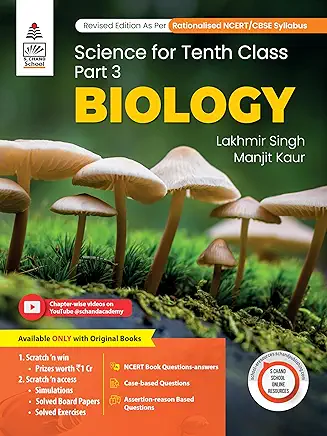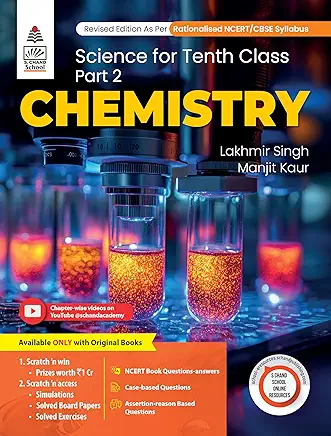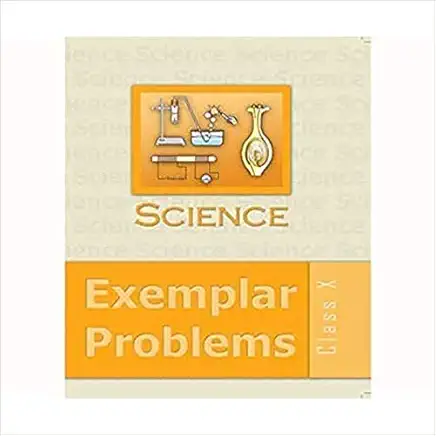CBSE Class 10 Biology: Our Environment - Part 7: Important Concepts
Welcome to Part 7 of our 8-part series on Our Environment. This post is a complete revision guide, covering all the important definitions, concepts, and diagrams you need to know for your board exams.
Recommended Books for Deep Practice
Concept 1: What is an Ecosystem?
Definition
An ecosystem is a functional unit of nature where all living organisms (biotic components) interact among themselves and with their surrounding non-living (abiotic) physical environment.
- Natural Ecosystem: Exist in nature on their own. E.g., Forest, Pond, Lake, Ocean.
- Artificial Ecosystem: Man-made and maintained ecosystems. E.g., Crop field, Aquarium, Garden.
Concept 2: Components of an Ecosystem
Biotic Components (Living)
- Producers (Autotrophs): Organisms that make their own food using sunlight (photosynthesis).
Example: Green plants, Algae. - Consumers (Heterotrophs): Organisms that depend on other organisms for food.
- Herbivores (Primary Consumers): Eat plants. E.g., Deer, Rabbit.
- Carnivores (Secondary Consumers): Eat herbivores. E.g., Fox, Wolf.
- Top Carnivores (Tertiary Consumers): Eat other carnivores. E.g., Lion, Eagle.
- Omnivores: Eat both plants and animals. E.g., Humans, Bears.
- Decomposers (Saprotrophs): Microorganisms that break down dead organic matter and waste products.
Example: Bacteria, Fungi.
Abiotic Components (Non-Living)
These are the non-living physical and chemical factors of the environment.
Examples: Sunlight, Air (CO₂, O₂), Water, Temperature, Soil, Minerals.
Concept 3: Food Chain and Trophic Levels
Food Chain
A food chain is a linear sequence of organisms showing "who eats whom," which represents the flow of energy in an ecosystem.
T1: Producers
Grass
T2: Primary Consumer
Grasshopper
T3: Secondary Consumer
Frog
T4: Tertiary Consumer
Snake
Trophic Levels
These are the various steps or levels in a food chain at which the transfer of energy takes place.
- First Trophic Level (T1): Producers (Plants)
- Second Trophic Level (T2): Primary Consumers (Herbivores)
- Third Trophic Level (T3): Secondary Consumers (Carnivores)
- Fourth Trophic Level (T4): Tertiary Consumers (Top Carnivores)
Concept 4: 10% Energy Law
Definition
Proposed by Raymond Lindemann, this law states that only 10% of the energy is transferred from one trophic level to the next. The remaining 90% is lost to the environment as heat during metabolic processes (like respiration, digestion, etc.).
Consequences
- Energy is Unidirectional: Energy flow is one-way (Sun -> Producer -> Consumer) and is lost at each step. It cannot be recycled.
- Limited Trophic Levels: Due to this massive energy loss, food chains are typically limited to 3-4 trophic levels. There is not enough energy left to support a 5th or 6th level.
Concept 5: Food Web vs. Food Chain
Food Web
A food web is a network of multiple, interconnected food chains. It represents the complex, realistic feeding relationships in an ecosystem.
Stability
A food web is more stable than a simple food chain. Why? Because it provides alternative food sources. If one prey population (e.g., rabbits) decreases, the predator (e.g., fox) can survive by eating other prey (e.g., rats), preventing the collapse of the ecosystem.
Concept 6: Biomagnification
Definition
Biomagnification is the process of increase in the concentration of a harmful, non-biodegradable chemical (like DDT or mercury) at each successive trophic level of a food chain.
Why does it happen?
These chemicals are not broken down or excreted by organisms. Instead, they get stored in the body's fat tissues. When a consumer eats multiple organisms, it accumulates all the toxins from those organisms.
Result
The highest concentration of the toxin is found at the highest trophic level (top consumers), which can cause diseases, reproductive failure (e.g., thin eggshells in birds), and death.
Related Posts
Concept 7: Ozone Layer
Formation
The ozone layer (O₃) is formed in the stratosphere when high-energy UV rays split molecular oxygen (O₂) into free oxygen atoms (O). These free atoms (O) then combine with other oxygen molecules (O₂) to form ozone (O₃).
Importance (Good Ozone)
It acts as a protective shield, absorbing 97-99% of the sun's harmful UV-B radiation, protecting life from skin cancer, cataracts, and immune system damage.
Depletion
It is being destroyed by man-made chemicals, primarily Chlorofluorocarbons (CFCs), which were used in refrigerators, ACs, and aerosols. The Montreal Protocol (1987) was the international treaty signed to ban CFCs, which has led to the slow recovery of the ozone layer.
Concept 8: Waste Management
| Parameter | Biodegradable Waste | Non-Biodegradable Waste |
|---|---|---|
| Definition | Waste that can be broken down by microorganisms (bacteria, fungi). | Waste that cannot be broken down by microorganisms. |
| Examples | Vegetable peels, leftover food, paper, cotton, jute, cow dung. | Plastic, glass, metal, pesticides (DDT), rubber. |
| Environmental Impact | Generally harmless, can be used to make compost (manure). | Causes pollution, fills landfills, and can cause biomagnification. |
| Disposal Method | Composting, Biogas Plant | Recycling, Landfill, Incineration |
Concept 9: The 3 R's Strategy
The 3 R's to Save the Environment
- Reduce: This is the best method. It means using less of a resource. This stops waste generation at the source.
Example: Turning off lights/taps, not buying unnecessary items. - Reuse: This means using an item multiple times for its original or a new purpose.
Example: Using a cloth bag for shopping, refilling a water bottle. - Recycle: This means processing waste material to make a new product. This uses energy but is better than dumping in a landfill.
Example: Sending old paper, glass, or plastic to a recycling plant.






